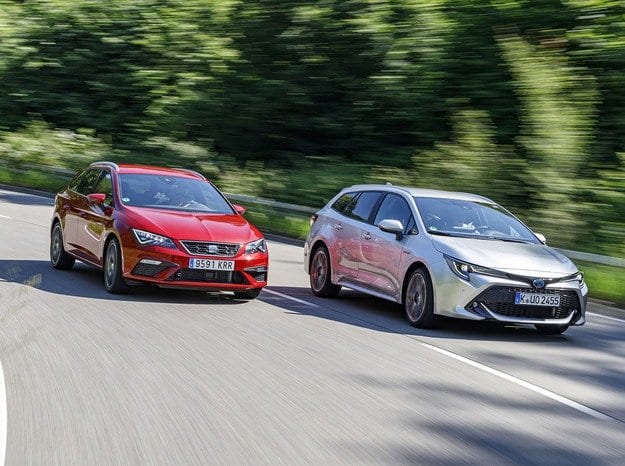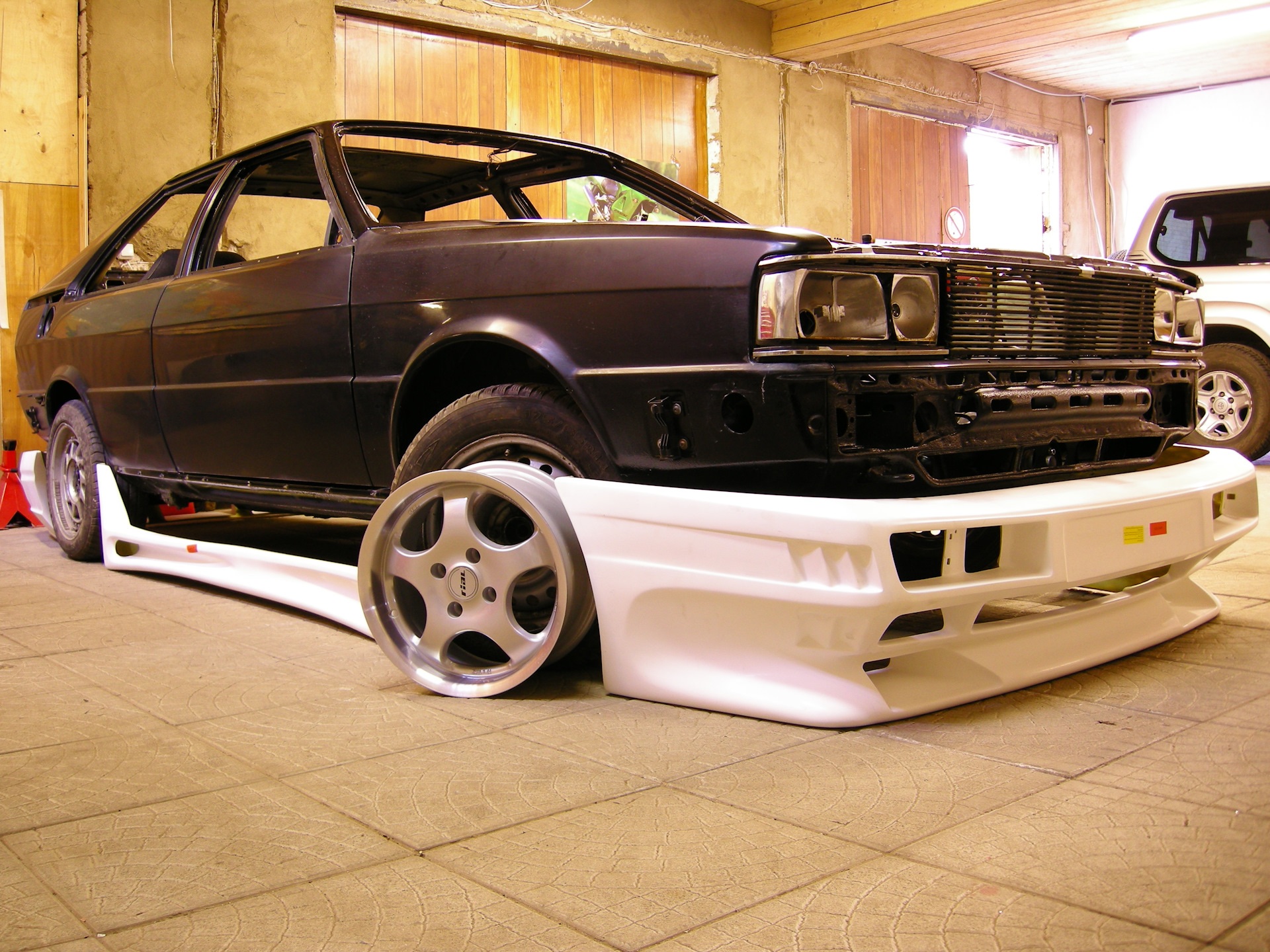
Test drive gasoline versus hybrid

Seat Leon St 2.0 FR, Toyota Corolla TS 2.0 Hybrid - two compact station wagon models
Toyota sent the new Corolla station wagon for the first comparative test in the 2.0 Club version with a hybrid drive and 180 hp. It will compete with the tested Seat Leon ST FR with a 190 hp gasoline engine.
Compact station wagon models smell reasonable, and even more so with a hybrid drive. Toyota knows this well, which is why Auris' successor, the Corolla hatchback, is available for the first time in a second, much more powerful hybrid variant. As an option, the Touring Sports 2.0 Hybrid Club station wagon with 180 hp. The model's power system costs about the same as the Seat Leon ST in the FR sports version with a two-liter turbo engine and 190 hp. The question arises which of the two machines offers the better package of fun and common sense.
Let's start with the qualities inherent in any station wagon. Toyota offers 581 liters of standard luggage space, while Seat offers six liters more. Both models have a movable, height-adjustable boot floor, but Leon also has openings on both sides of the aisle for long loads. The Corolla counteracts the slightly higher maximum load volume and safety net that is part of the Club's equipment. Both machines have mesh attachment brackets behind the front and rear seats. The rear seat is almost identical - after adjusting the driver's seat, as for our test Tuigi, the rear seats of both models have 73 centimeters of hip room. Due to the rather high rear seat, headroom in the Toyota is significantly less, but still sufficient.
Accordingly, the first conclusion is that the shorter Leon ten centimeters uses space more efficiently. However, only Corolla had to reserve space for hybrid components. The battery is located in front of the multi-link rear axle, above the 43-liter gas tank. In front of the gasoline engine are two electric motors with generator function, which are in a common housing with a planetary gearbox.
Electric drive limits maximum speed
The sophisticated drivetrain is the reason for protecting the 80-kilowatt electric unit to limit the top speed to 180 km / h, because at this rate the electric motors are already spinning at around 13 rpm. Petrol four-cylinder engine with a capacity of 000 hp produces from 153 rpm and above solid for a two-liter atmospheric unit of 4400 Nm. The system power is 190 hp, i.e. only 180 hp. less than the power of Leon's turbo engine with the same displacement. Starting at 10 RPM, there is a serious 1500 Newton meters that can be activated quite quickly for a forced-charge engine.
After all, Toyota not only offers a lower top speed of 52 km / h, but also a weaker sprint. From a standstill, the Corolla reaches 100 km / h in 8,1 seconds (according to the company), but we did not measure less than 9,3 (the Seat has 7,7). The scissors dissolve more and more at an increasing rate. Five seconds behind at 160 km / h, finally at 180 it becomes nine. During comparative driving, the measured values are also confirmed outside the left lane of the freeway. Especially on a steep road with tight turns, the Corolla cannot accelerate normally. Here, with constant operation under heavy load, electrical acceleration is practically not felt. Yes, the drive responds with virtually no delay, but with a naturally aspirated engine, this would be without the help of electricity.
In tighter turns, the hybrid wagon tilts slightly at first, but when the body finds strong wheel support outside the corner, the car impresses with good precision and not too slow. The comfortable steering wheel of the Japanese woman is consistent with her character and creates a reasonable basis for trust between the driver and the car, which ensures a smooth yet energetic drive.
Spaniard with GTI talents
In the Leon FR, everything can become amazingly sporty, because it can be driven around corners much faster and more dynamically. The same exercise will throw the Corolla out of balance - both when entering a turn, and when turning. The Seat's steering is not only significantly more dynamic; it fits perfectly with the adaptive suspension, which, however, costs 800 euros extra.
All in all, the FR's road dynamics matter a lot for a model that isn't unequivocally sporty - one reason is that the power of the four-cylinder engine is perfect for the job. This gives a solid package, only the braking system could be even better. At Toyota, this is more relevant because 38 meters of stopping distance at 100 km / h is almost an acceptable result, while 36 meters for the Seat is still a good result. The Corolla also can't provide the Spanish model's excellent brake pedal feel, so the brake force metering is sometimes not entirely intuitive. However, for a hybrid car, the settings are quite successful, as the transition from recuperation to mechanical braking is effectively masked.
The hybrid shows its advantages mainly when driving around the city. Even on the AMS highway for everyday driving (in the city and on a secondary road), an average of 6,1 l / 100 km of gasoline is enough, i.e. 1,4 liters less than Leon needs. In clean city traffic, the difference in consumption can widen even further, because with continuous starting and stopping with frequent recovery phases, the XNUMX kW battery remains charged long enough to drive the electric motors.
Corolla shines in the city
At light load, the Toyota model most often travels the first meters on electric traction and starts the gasoline engine only when it needs to accelerate more. This happens quite smoothly - also because the infinitely variable torque adaptation of the planetary gear is almost vibration-free. Only on descents there are occasional slight jolts, when at a low gas supply the transmission hesitantly searches for the correct gear ratio - with the corresponding sound accompaniment. And let's add: with a sporty driving style, the Corolla swallows more gasoline than the Leon.
The driving comfort of both station wagons is not to be found fault with. True, for Corolla adaptive dampers can only be ordered in the highest configuration Lounge, but the standard chassis is so balanced that it reliably absorbs bumps, but retains pronounced vertical body movements. Leon's suspension works in the same way in the normal mode of the shock absorbers, but the bumps are more solid with the idea. In Comfort mode, Seat increases spring travel and rides as smoothly as a Toyota.
Another contribution to the comfort of the Leon is the adjustable length and height of the armrest between the front seats. In addition, the model offers a deeper seating position, finer backrest adjustment via a rotary knob and better lateral support with the same seat comfort. In addition, the workmanship is more meticulous in some parts, and the engine, which will only be available in the Leon until autumn, is more versatile.
But even in a Corolla, it's not difficult to feel - clear control of functions, comfortable seats, enough space for small things, a decent combination of materials. And an efficient drive allows you to show enough temperament to drive a car without much effort. At the same time, in a more powerful hybrid, the advantages of the Corolla are manifested in a calm driving style. Van owners who occasionally want to drive dynamically in more than just straight lines will find a versatile amateur athlete in León. And one that brings driving pleasure to the fore much more – with all its common sense.
Text: Tomas Gelmancic
Photo: Ahim Hartmann
